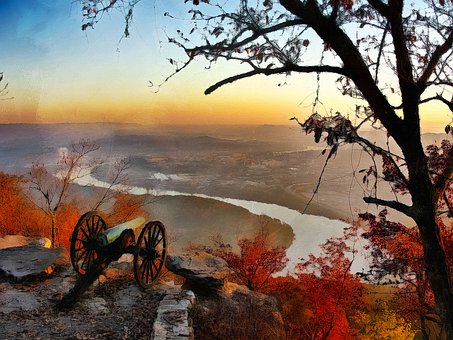George Henry Thomas was born in 1816, near Yorktown, Virginia, into a family of prosperous farmers. At the age of 15, his family narrowly escaped being murdered during Nat Turner’s slave revolt when their farm was attacked. Despite his narrow escape, Thomas never exhibited prejudice, treating everyone equally and fairly.
When Thomas was 19 years old, he received an appointment to West Point Military Academy. One of his roommates was William Tecumseh Sherman and Ulysses S. Grant, arrived as a plebe during his final year. Thomas received his commission in 1840 and was a career officer.
In 1861, as southern states seceded, Thomas was the most prominent southerner to side with the Union. Unfortunately, southerners were distrusted and he had no political power brokers in Congress to advocate for him. As a result, Thomas watched less competent officers get promoted ahead of him.
Thomas is important to Tennessee because he fought in virtually every Civil War battle in the state. He also commanded the Union occupation forces in Nashville. He is most famous today for the Battle of Chickamauga, Georgia.
On September 19, 1863, Confederates attacked the Union line at Chickamauga Creek. Billy Yanks dropped their Springfield rifles and fled back to Chattanooga. Only Thomas’ troops remained fighting although they were outnumbered two to one. In late afternoon, a relief force arrived led by General James B. Steedman. He found Thomas standing alone in a clump of trees watching the Confederates attack both flanks.
Thomas pointed to the right side of the line and calmly ordered, “Take that ridge”. Steedman’s troops charged in a suicidal attack that shocked the Confederates and saved the day. That night Thomas’ troops obeyed orders to retreat to Chattanooga. Soldiers and news reporters nicknamed him, “The Rock of Chickamauga.”
A couple of months later in November 1863 Thomas’ plan of attack was adopted at the Battle of Chattanooga. Under his plan the Union forces successfully flanked the Confederate defenses which reduced casualties on both sides. The Confederates retreated into Georgia.
At that point, Grant sent Thomas back to Nashville to command the Union occupation troops, consisting mostly of U.S. Colored Troops which Grant and Sherman didn’t want in their commands. Sherman set off on his March to the Sea. Unfortunately for Sherman, the Confederate army easily eluded him and returned to Tennessee.
On November 30, 1864, the Confederate forces won the Battle of Franklin and advanced on Nashville. They took up positions south of today’s I-440 anchored in the east along Murfreesboro Road and in the west along Hillsboro Road.
On December 15, 1864, Union troops formed up in the Belmont/West End area and moved south along Hardin Pike (West End/Harding Road). Then they wheeled left and hit the Confederate positions along the east side of Hillsboro Pike.
By December 16th, the Confederates had been pushed south to Shy’s Hill (west of Granny White Pike) and Overton Hill (near Franklin Pike). By day’s end, the Confederate forces were fleeing south down Franklin Pike. Their shattered army never fought again. The Battle of Nashville is notable today because it’s the only Civil War battle in which Union Colored (African-American) Troops led the main attack.
June is a wonderful time for exploring the historic markers scattered along West End Avenue, Hillsboro Road, Granny White Pike and Franklin Road. (Use common sense when parking or walking along these busy roads.) Fort Negley anchored the Union defenses and is now part of the Greenways of Nashville. Also recommended is a visit to Mt. Olivet Cemetery to see the Confederate Circle and the mausoleum of Adelicia Acklen, owner of Belmont Mansion.
Thomas died from an aneurysm in 1870. He never wrote a memoir because he considered tell-all books undignified and unsoldierly. As a result, his reputation suffered when Sherman and Grant trashed him in their memoirs.
To learn more about this fascinating man read Master of War, by Benson Bobrick (2009)
Want to receive this blog straight to your inbox? Sign up for my mailing list.






